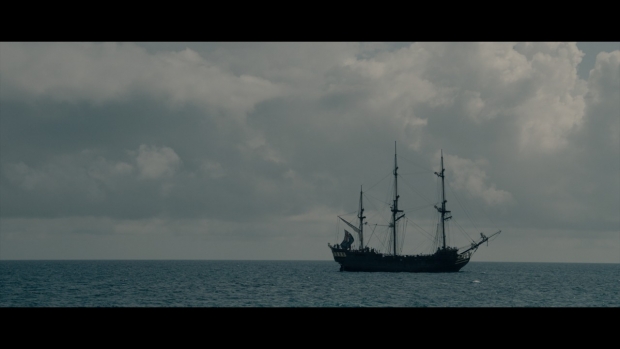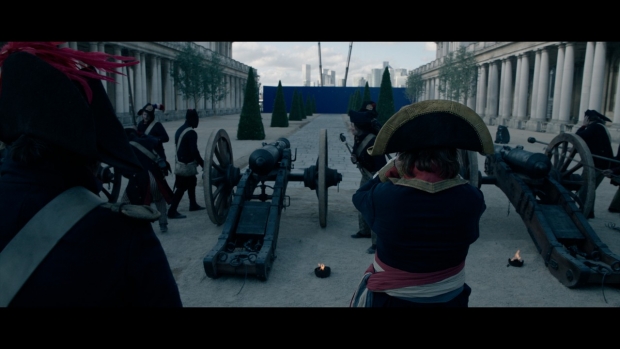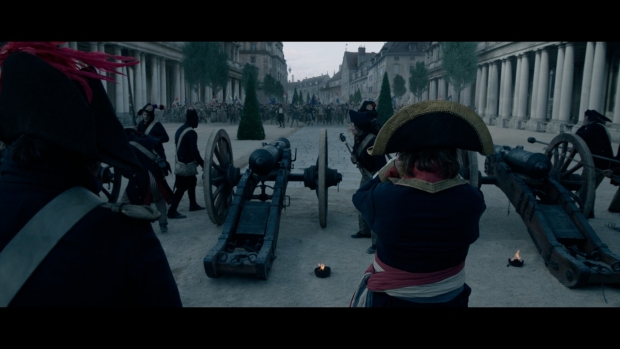Studio delivered 126 VFX shots to help realize Ridley Scott’s vision of Napoleon’s 1793 Siege of Toulon and his violent suppression of the Paris riots two years later.
Award-winning, London-based independent visual effects studio BlueBolt shared a VFX breakdown reel showcasing its recently completed work on Napoleon, Ridley Scott’s epic depiction of the rise and fall of French Emperor Napoleon Bonaparte (Joaquin Phoenix). Led by VFX supervisor Henry Badgett, the studio delivered 126 VFX shots to support Scott’s vision of Napoleon’s 1793 Siege of Toulon and his violent suppression of the Paris riots two years later.
Badgett collaborated closely with the production’s overall VFX supervisor, Charley Henley, to interpret Scott’s storyboards and ensure BlueBolt’s work recreated the envisioned immersive, visceral tone. Reference paintings and engravings of the events from the period informed the studio’s VFX work.
The Siege of Toulon was one of the first major Napoleonic battles. Napoleon demonstrated his tactical genius by leading an attack by night on an English stronghold previously deemed impenetrable. BlueBolt created 90 shots split between the daytime “before” and the dramatic nighttime battle in the Port of Toulon.
Creating a plausible and consistent geography for the Toulon Harbor environment was a significant challenge, with filming shot at several locations in Malta, including a set build surrounded by bluescreen. BlueBolt’s brief was to tie these separate locations together with 3D and DMP environment work, to replicate crowd, to add the British fleet in the harbor (including CG sailors) with a fully rigged recreation of the British fleet in the Mediterranean - including HMS Victory - and to enhance the battle with a wide range of FX work which climaxes with the explosion of the ammunition-carrying ship “Iris.”
“The FX and lighting work were key as the FX explosions and flashes also needed to light the scene vastly more than if it were daytime,” explained Badgett. “As a result, the timing and animation of these mortar explosions were crucial and needed careful execution, also requiring off-screen as well as on-screen explosions to achieve the immersive feel of the dramatic battle.”
He continued, “The team at BlueBolt brought their experience from numerous past projects with CG historic ships, building a hero model for each of the six or seven classes of ship and from there making three or four variations of each of those to form the fleet, before adding intricate period rigging, sails, and flags with rope and cloth sims. To help with this, we received reference from an element shoot in which production built 1/16th scale miniatures that were then attacked by cannon balls from the SFX department and set on fire.”
The Paris riots cover the historical events of the “13 Vendémiaire,” the name given to a battle between the French Revolutionary troops and Royalist forces in 1795. This battle was part of establishing a new government and a significant factor in the rapid advancement of Bonaparte's career.
BlueBolt’s brief was to extend the environment, replicate the crowd, add CG crowd, and then apply riot-control cannon grapeshot fire into the crowd. Shots were filmed at Greenwich Naval College in London, a location the studio’s team was familiar with from previous projects. In extending the environment, the challenge was to present a new look at a familiar location and to work sympathetically with the architecture while adding to it to create a new Parisian street look and feel.
The production’s historical advisor, UAL’s Inigo Minns, supported Badgett’s research of Paris Architecture. One wing of the Louvre Palace in Paris was the key reference for an administrative building in the background behind Napoleon’s soldiers. BlueBolt rebuilt it in 2.5D, giving the Greenwich Old Naval College a French-style mansard 3D roof top-up. In the other direction, behind the crowd of rioters, a DMP based on very rough geometry for scale and perspective was added, using additional Louvre references from Inigo.
For the crowd replication layers, BlueBolt painted out jerk-rig wires from an entire row of crowd and individually tracked on blood patches and removed limbs from victims after the cannon fire. CG crowds filled some gaps with motion capture performed by stunts from a session at the Imaginarium in Ealing Studios. The crowd waved large flags, with some replaced by 3D simulations to allow for violent tearing from the cannon shot. Finishing the shots were 2D element dressing for cannon fire, smoke, torn fabric floating in the air, and two types of blood - a misty blood vapor and a wet blood spray. The crowd throws various 3D bottles and individually hand-animated stones.
“Napoleon not only boasts significant VFX set pieces but also integrates subtle VFX throughout the cut,” noted Badgett. “These small touches collectively contribute to creating the immersive and atmospheric experience of Ridley Scott’s Napoleon, and we are proud to have been part of it.”
Check out BlueBolt’s VFX Breakdown – Napoleon:
Napoleon premiered in cinemas November 22 and will stream on Apple TV+ in 2024.
BlueBolt is currently in production on projects including Robert Eggers’ Nosferatu and recently delivered work on HBO’s True Detective.
Source: BlueBolt















